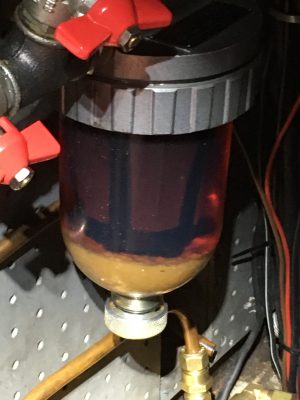When diesel bug raises its ugly head, Jonty Pearce learns some valuable lessons
A couple of years ago I took the precaution of fitting a Fuel-Guard FDG1120 fuel polisher to Aurial, (YM April 2016), hoping never to notice it working.
I therefore experienced mixed feelings when, on our summer passage to the Isles of Scilly, the fuel polisher alarm went off and a swift check of its filter bowl revealed a 1cm tell-tale layer of yellow contamination swilling about in the base.
We had just left Padstow and the Camel Estuary to motorsail round the choppy overfalls off Trevose Head; ideal turbulent circumstances to stir up hitherto undiscovered sludge in the bottom in the bottom of a fuel tank, but hardly comfortable conditions for cruising yachtsmen.
Fortunately, the filter protected Bertie the Bukh 36 and he never missed a beat.
The headland and its overfalls were soon passed, and when the corner was turned the seas became flatter. I trimmed the sails, turned off the engine, handed the helm to Carol, and went below to clean out the filter.
Aurial’s polishing system centres on Fuel-Guard’s FDG100 unit, comprising a filter with water separator and coated 30-micron stainless steel element. With suitable bypass valves and a timer, I can set an auxiliary electric pump to suck diesel from the tank for filtering before being reunited via the engine return line.
When out on the water under motor, I switch the valves over to eliminate the auxiliary pump; the fuel then simply passes through the Fuel-Guard unit, using it as a pre-filter before continuing to the original primary and secondary filters.
Continues below…
Jonty Pearce: The wind doth howl
Jonty Peace reflects on the perils of wild weather as he rides out the tail end of Opheila
Jonty Pearce: Cat afloat
Jonty Pearce cat-proofs his boat ahead of voyages with the beloved family pet
Jonty Peace: Passage to the Isles of Scilly
Jonty Peace points his bow towards the Isles of Scilly and rediscovers the joys of cruising the south west coast
An alarm sounds if water appears in the polishing unit’s filter bowl; if caught in time it protects the primary filter from contamination. The FDG100’s stainless steel filter mesh can be removed and washed in fresh diesel; a gentle scrub with an old toothbrush enhances the procedure.
It was an easy job to unscrew the filter bowl, catch the spilling diesel in a bowl, and extract the mesh filter. Once all was clean, I reassembled it and filled the bowl, letting any air out in the process.
The diesel system does not then require bleeding, and the engine fired up immediately on turning the key. Our trip continued with gentle winds down to St Ives, where Bertie behaved impeccably.
The next day’s passage was across to the Isles of Scilly – sailing all the way apart from one hour motorsailing. The fuel in the filter bowl remained pristine, and the engine did not falter once.
Once we had dried out in our favourite Scillonian anchorage, Green Bay on Bryher, I knew we had to investigate the fuel tank. Unfortunately, Aurial’s diesel tank is not fitted with a sump and drain point – furthermore, it seems impossible to fit one.
My solution had been to fit a Tec-Tanks FLB Inspection Hatch; once the lazarette had been emptied and its floor removed to reveal the fuel tank, the inspection hatch was soon removed to reveal clean-looking diesel.
Any water or debris would be at the bottom, so Carol and I rigged up a hand pump and long pick-up tube stiffened with a garden cane. We ended up pumping about ten litres of contaminated fuel into old bottled water containers.
Water and fuel bug sediment formed a mucky layer in the bottom inch or so; rather than try and separate it to re-use the fuel it was disposed of responsibly. The tank was clean! The inspection hatch, lazarette floor and its contents were replaced, and we sat back in the sun to sip a rewarding Pimms, though I’m afraid the enjoyment was slightly marred by the stink of diesel…
So, why was there water and sludge in the tank? Had we picked up dirty fuel on our passage down? There had been no trace of a problem previously despite some significantly rough seas, so it is quite possible.
Had condensation and diesel bug gradually developed over the eight years since I had last cleaned out the tank? Was the diesel bug additive I use ineffective? And why had the fuel polisher not kept the tank clear?
I have no firm answer to these questions; it is well known that no prevention system is perfect and that nothing will protect you if you get a fill of filthy fuel. The polisher draws its feed from the engine fuel line which emerges an inch or two higher than the bottom of the tank, and sediment can coat its base below the level of the outlet.
Rough seas do quickly stir everything up, and I was fortunate to be alerted to my problem by the fuel polisher alarm. Naturally, prevention is the best cure: I now intend to draw up some fuel from the tank base at the start of each season.
I would encourage those fortunate to have a testing sump in their tank to use it for a regular fuel check, and recommend that all sailors should follow sensible diesel bug avoidance precautions such as using additive and maintaining a full tank over winter to minimize condensation.
Remember that modern FAME containing Bio-fuels are more hygroscopic and have a shorter shelf life; this further strengthens my relief that I fitted a fuel polisher, though I am planning to reward my unit with a dedicated pick-up pipe set as low in the tank as possible.
All this will help, but the best advice is not to let your diesel go stale – use your boat frequently!







